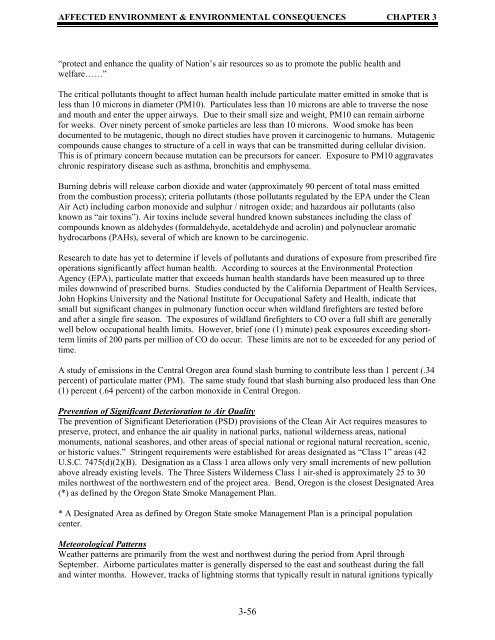Environmental Assessment
Environmental Assessment
Environmental Assessment
You also want an ePaper? Increase the reach of your titles
YUMPU automatically turns print PDFs into web optimized ePapers that Google loves.
AFFECTED ENVIRONMENT & ENVIRONMENTAL CONSEQUENCES CHAPTER 3<br />
“protect and enhance the quality of Nation’s air resources so as to promote the public health and<br />
welfare……”<br />
The critical pollutants thought to affect human health include particulate matter emitted in smoke that is<br />
less than 10 microns in diameter (PM10). Particulates less than 10 microns are able to traverse the nose<br />
and mouth and enter the upper airways. Due to their small size and weight, PM10 can remain airborne<br />
for weeks. Over ninety percent of smoke particles are less than 10 microns. Wood smoke has been<br />
documented to be mutagenic, though no direct studies have proven it carcinogenic to humans. Mutagenic<br />
compounds cause changes to structure of a cell in ways that can be transmitted during cellular division.<br />
This is of primary concern because mutation can be precursors for cancer. Exposure to PM10 aggravates<br />
chronic respiratory disease such as asthma, bronchitis and emphysema.<br />
Burning debris will release carbon dioxide and water (approximately 90 percent of total mass emitted<br />
from the combustion process); criteria pollutants (those pollutants regulated by the EPA under the Clean<br />
Air Act) including carbon monoxide and sulphur / nitrogen oxide; and hazardous air pollutants (also<br />
known as “air toxins”). Air toxins include several hundred known substances including the class of<br />
compounds known as aldehydes (formaldehyde, acetaldehyde and acrolin) and polynuclear aromatic<br />
hydrocarbons (PAHs), several of which are known to be carcinogenic.<br />
Research to date has yet to determine if levels of pollutants and durations of exposure from prescribed fire<br />
operations significantly affect human health. According to sources at the <strong>Environmental</strong> Protection<br />
Agency (EPA), particulate matter that exceeds human health standards have been measured up to three<br />
miles downwind of prescribed burns. Studies conducted by the California Department of Health Services,<br />
John Hopkins University and the National Institute for Occupational Safety and Health, indicate that<br />
small but significant changes in pulmonary function occur when wildland firefighters are tested before<br />
and after a single fire season. The exposures of wildland firefighters to CO over a full shift are generally<br />
well below occupational health limits. However, brief (one (1) minute) peak exposures exceeding shortterm<br />
limits of 200 parts per million of CO do occur. These limits are not to be exceeded for any period of<br />
time.<br />
A study of emissions in the Central Oregon area found slash burning to contribute less than 1 percent (.34<br />
percent) of particulate matter (PM). The same study found that slash burning also produced less than One<br />
(1) percent (.64 percent) of the carbon monoxide in Central Oregon.<br />
Prevention of Significant Deterioration to Air Quality<br />
The prevention of Significant Deterioration (PSD) provisions of the Clean Air Act requires measures to<br />
preserve, protect, and enhance the air quality in national parks, national wilderness areas, national<br />
monuments, national seashores, and other areas of special national or regional natural recreation, scenic,<br />
or historic values.” Stringent requirements were established for areas designated as “Class 1” areas (42<br />
U.S.C. 7475(d)(2)(B). Designation as a Class 1 area allows only very small increments of new pollution<br />
above already existing levels. The Three Sisters Wilderness Class 1 air-shed is approximately 25 to 30<br />
miles northwest of the northwestern end of the project area. Bend, Oregon is the closest Designated Area<br />
(*) as defined by the Oregon State Smoke Management Plan.<br />
* A Designated Area as defined by Oregon State smoke Management Plan is a principal population<br />
center.<br />
Meteorological Patterns<br />
Weather patterns are primarily from the west and northwest during the period from April through<br />
September. Airborne particulates matter is generally dispersed to the east and southeast during the fall<br />
and winter months. However, tracks of lightning storms that typically result in natural ignitions typically<br />
3-56
















